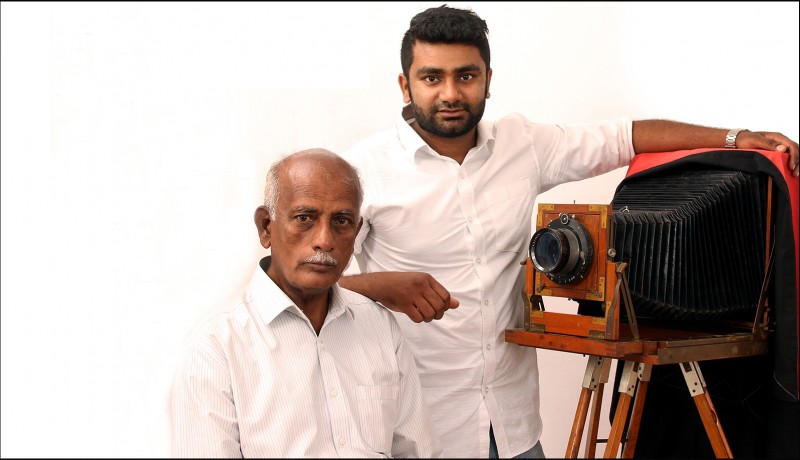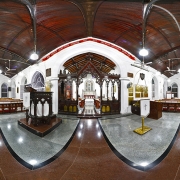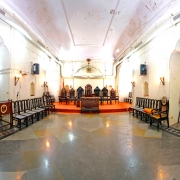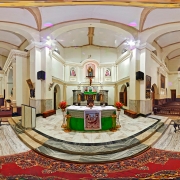
People

Master photographer Lenny Emmanuel carries forward his family’s mission to document the heritage of Hyderabad
A little more than two years ago, Hyderabadi readers of the Deccan Chronicle woke up to find picture stories of some of the city’s most beloved monuments in the newspaper’s supplement, the Hyderabad Chronicle. If one week it was Mah Laqua Bai Chanda’s grave with the shrine of Moula Ali in the background; the next week it was the ornate interiors of the Swaminarayan Temple; and the next, the fabulously rich interiors of churches.
But the most memorable of them all was a panoramic view of the Jama Masjid and the Charminar in one single shot: monuments separated by a physical distance of 30,000 ft. Suddenly, their rich heritage and the man who had served it with the city’s morning coffee had become a talking point.
That man is master photographer Lenny Emanuel, a passionate Hyderabadi whose family has been documenting the city for more than a century. Known for his industrial photography, which means pictures of factories, architecture, corporate offices and products, the 70 year-old clarifies: “I shoot everything, from a needle to an aircraft.”
Lenny’s family has always shared a special relationship with Hyderabad. His grandfather, Mario Francis Emanuel from Pondicherry, a soldier of fortune, followed Michel Joachim Marie Raymond, the Frenchman who became a general in the Nizam’s army, to Hyderabad. Mario decided to venture into the then budding art of photography and set up M F Emanuel & Co in 1881, one of the earliest photo studios in the twin cities. While his son continued with his profession, it was Mario’s grandson, Lenny’s father Charles Emanuel, who put the family in the spotlight. Charles became the chief photographer for the Nizam on the Nizam Sagar dam project, now in Telangana.
Living on site for 20 years while the project developed, Charles used to make large-scale layout models of the projects he worked on, besides clicking professional photographs of them. These models were made mainly for exhibitions, to show the public what the project would look like once completed. He was also a professional draughtsman, who worked on the handsome Osmania University complex and maintained photographic records of the stages of its development.
“My dad’s eye for detail and meticulous design sense probably gave me my first lessons in fine detailing,” says Lenny, who inherited Premier Studios at Marredpally, which his father had opened at the age of 60. Sadly, except for a few priceless glass slides and a vintage camera, there is very little left of his father’s work or original studio equipment.
“I dropped out of school at the age of 12 to join my dad in his studio,” says Lenny, whose moment of glory came pretty early on, at the age of 14. “A friend had asked me to click his wedding photographs. Later, he brought the roll to our studio to get the film developed. My father looked at the images and said, ‘These photographs are very good, who has done them?’ I was very happy but I did not have the courage to tell him I had clicked them.”
In the mid-1970s, just as Lenny was coming of age, he met Mitter Bedi, a leading industrial photographer, who inspired him to follow in his footsteps. There was no stopping the lad, who went on to become a well-known photographer in the advertising and industrial sectors, building a large body of work with leading public-sector undertakings and private companies too. Indeed, Lenny has won many accolades and prizes for his photography. His most enjoyable experience was doing the brochure for Hindustan Aeronautics Ltd in 1987-88, where 120 of his images were included in a prize-winning brochure. He also won an ADEX (Excellence in Advertising) Award in 1993 for the HAL brochure, another ADEX award in 1999 for a brochure for Asian Engineering, in 2001for Monoroy Advertising, and in 2004 for Image Ads.
Lenny also ventured into teaching, conducting workshops first on Canon cameras and later the Hasselblad, or the “Rolls Royce of cameras”. He conducted them at Hyderabad’s Jawaharlal Nehru Technical University. The university then invited him to teach its bachelor of fine arts students at its Masab Tank campus. Then followed a stint for architecture students—and thus it carried on.
Today, the master lensman is happy that his son, Edwin, is taking the Emmanuel legacy forward. “He took to photography of his own free will; there was no coercion, no grooming. Nowadays, we go together on locations.” Edwin is the youngest of Leny’s three sons. He has always been fond of art and, till 2012, he preferred to call himself a graphic artist and a specialist in interiors. He cannot recall when he shot his first photograph but he feels he has found his true calling because he now marries his sense of art and photography. Just like his father, he works on a freelance basis and also like his father, specialises in industrial photography as well as advertising. “As of now, I am happy following in Dad’s footsteps. In future, I may move on to special effects,” says the youngster.
Lenny admits computers have taken photography to an altogether different level. With smart phones getting smarter, photography seems to have come out of its ivory tower and lost its exclusivity. Yet photographs for publishing and printing are still done the traditional way.
For a man who walked 25 km through the dirt tracks of Madhya Pradesh to get to the Korba Steel Plant for an assignment, it is not surprising that he still loves to shoot on film. But that doesn’t mean he doesn’t use digital cameras. “I never use them in ‘autofocus’ mode, though, only manual mode, where I have to adjust all the parameters myself,” he says with a smile.
Lenny plans to publish a coffee-table book. Till then, he continues to click unusual pictures of the lost and forgotten nuggets of history of his beloved Hyderabad. “I want people to remember and preserve the heritage and culture of this great city. Sometimes, when I am up on a sling and swinging from a light pole, I get such a dramatic perspective that my first thought is that I must share it with my people. I am very blessed to do what I do. One must never hesitate to click a picture you feel is good. Lie down on the floor, climb the stairs, get up on a tree, but get your shot!”
—Shyamola Khanna
June 2018
you may also like to read
-
For the love of Sanskrit
During her 60s, if you had told Sushila A that she would be securing a doctorate in Sanskrit in the….
-
Style sensation
Meet Instagram star Moon Lin Cocking a snook at ageism, this nonagenarian Taiwanese woman is slaying street fashion like….
-
Beauty and her beast
Meet Instagram star Linda Rodin Most beauty and style influencers on Instagram hope to launch their beauty line someday…..
-
Cooking up a storm!
Meet Instagram star Shanthi Ramachandran In today’s web-fuelled world, you can now get recipes for your favourite dishes at….










